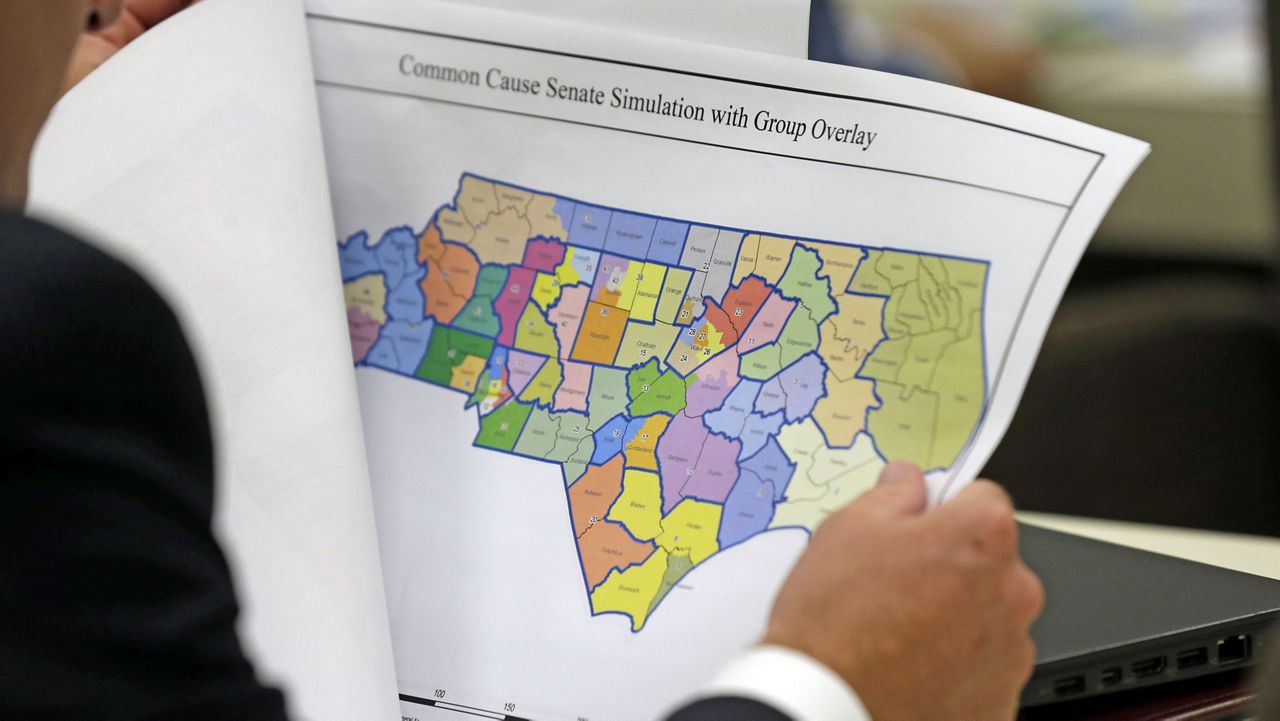RALEIGH, N.C. (AP) — With a new state budget completed, North Carolina legislators now turn their attention yet again to mapping the state's congressional and General Assembly districts.
The House and Senate redistricting committees scheduled hearings this week — the last one happened Wednesday in Raleigh — to receive public comment about the process of drawing district boundaries that would be used in the 2024 elections and for the remainder of the decade.
What You Need To Know
- North Carolina legislators are once again mapping the state’s congressional and General Assembly districts
- The House and Senate redistricting committees scheduled hearings this week to receive public comment about the process of drawing district boundaries to be used from the 2024 elections through the end of the decade. Redistricting already happened in 2021
- The state Supreme Court initially struck down the maps the General Assembly drew, but a new version of that court this year reversed the previous decision
- Now another set of maps should be voted on in October
Redistricting in North Carolina seems to be endless. Since 2011, six different versions of maps for the state’s congressional delegation, the state House and state Senate have been enacted by courts or lawmakers, although not all were used in elections.
Now another set should be voted on in October, with the Republicans who draw them seeking to retain or squeeze out more seats for their side on Capitol Hill and at the Legislative Building.
WHY ARE MAPS BEING DRAWN AGAIN?
Because state Supreme Court justices and the law said so.
Each redistricting cycle begins the year after each census. The GOP-controlled General Assembly drew congressional and legislative maps in fall 2021 based on the 2020 population data.
In February 2022, the state Supreme Court — with a Democratic majority at the time — struck down all three maps, declared the state constitution outlawed extensive partisan gerrymandering and ordered new boundaries. Ultimately, the legislature's second edition of General Assembly maps and an interim congressional plan drawn by trial judges were used in the 2022 elections.
But the Supreme Court flipped to a Republican majority, and in April the GOP justices reversed previous rulings and declared there was no constitutional prohibition on partisan gerrymandering.
State law already said that any court-drawn plan — like the 2022 congressional map — could only be used for one election cycle, setting up a redraw for 2024. And the justices also ruled in April that since the 2021 maps were never truly “established,” lawmakers must be given the opportunity to draw new General Assembly seat boundaries, too.
WHEN WILL THE MAPS GET APPROVED?
Senate leader Phil Berger told reporters he hoped votes on a congressional map would occur the week of Oct. 9, with votes on General Assembly lines later in the month.
Republicans hold comfortable seat majorities in both the House and Senate, so whatever lines are supported by the overwhelming number of them will be enacted. Redistricting legislation isn't subject to Democratic Gov. Roy Cooper's veto stamp.
WHO WILL GET THE UPPER HAND?
Republicans certainly will aim to draw lines that pick up more U.S. House seats and seek to secure their veto-proof majorities in the General Assembly for years to come.
Under the U.S. House map used in 2022, Democrats and Republicans each won seven seats. Political experts have said four current Democratic incumbents are vulnerable to having their current districts altered so that Republican chances to unseat them improve.
A congressional map approved by Republicans in 2021, but which never got implemented, would have given the GOP a strong chance to win 10 of the delegation's 14 seats.
ARE OTHER LIMITS PLACED ON THE MAPS?
A mosaic of state and federal court rulings, constitutions and the U.S. Voting Rights Act speak to criteria that mapmakers will follow.
For example, legislators must ensure that districts within the same statewide map are equal in population or close to it. Criteria in previous remapping also have aimed to keep districts compact and considered where current lawmakers live.
And General Assembly boundaries must comply with a requirement to minimize the number of districts that cross county lines. But the county groupings that result also must give way to Voting Rights Act requirements to ensure Black voters aren't in a worse position to elect favored candidates.
WILL LAWSUITS CHALLENGING THE NEW MAPS BE FILED?
Almost assuredly, as it has for every round of North Carolina remapping since the 1980s.
Litigation will have to begin quickly if critics want to prevent the use of maps starting with the March 5 primary elections. Candidate filing for 2024 begins Dec. 4.
North Carolina and U.S. supreme court decisions short-circuiting most partisan gerrymandering claims narrow the types of litigation likely to be successful. Accusations of racial gerrymandering and violations of other mapmaking criteria remain possible avenues in state or federal court.
Lawsuits may be the only way that citizens can gain more information about why lawmakers drew boundaries beyond their public talking points. Changes to public record rules in the state budget repeal a law that gave the public access to legislative records and communications related to redistricting as soon as maps were adopted.
Related article



